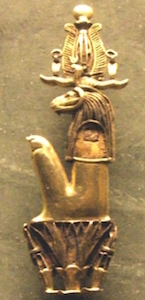Heryshef (Herishef, Heryshaf, Hershef) was an ancient creator, fertility god, and god of the riverbanks.
His name translates as “he who is on his lake”. His cult was located at Hwt-nen-nesu (Hnes, Herakleopolis Magna) but he was also referred to as the ruler of Iunu (Heliopolis).

The Palermo Stone records that his cult dated back to the first dynasty of Ancient Egypt (the Early Period) but the earliest known temple dedicated to him at Hwt-nen-nesu is dated to the Middle Kingdom. However, we know that he was fairly powerful during the First intermediate Period when Hwt-nen-nesu briefly became the capital of Lower Egypt.
The Temple of Heryshef was expanded during the New Kingdom by Ramesses II who added a number of huge granite columns with palm leaf capitals and remained active until well into the Ptolemaic Period.



In Ancient Egypt he was associated with Ra and Osiris and was sometimes described as the “Ba” (soul) of these gods. He was also associated with Atum because of his connections with the sacred naret tree of Hwt-nen-nesu. However, the Greeks called him Harsaphes or Arsaphes (which means “manliness”) and identified him with Heracles, perhaps in part because his name could also mean “He who is over strength”.
He appears on a stele found in the Temple of Isis in Pompeii (but originally from his temple in Hwt-nen-nesu) in which Heryshef assures Somtutefnakht (a priest during the Late Period) that he will not be harmed and advises him to return to his home town of Hwt-nen-nesu to serve in the temple. In this stele Heryshef is described as “king of the Two Lands” and “ruler of the riverbanks”. He is also referred to in the “Tale of the Eloquent Peasant” in which the peasant goes to register his complaint in the Temple of Heryshef. Heryshef was often depicted on ivory wands from the Middle Kingdom and amulets from later periods.
He took the form of a king with the head of a long-horned ram. He wore the Atef when associated with Osiris and the sun disc when associated with Ra.
Bibliography
- Bard, Kathryn (2008)An introduction to the Archaeology of Ancient Egypt
- Pinch, Geraldine (2002) Handbook Egyptian Mythology
- Redford Donald B (2002) Ancient Gods Speak
- Watterson, Barbara (1996) Gods of Ancient Egypt
- Wilkinson, Richard H. (2003) The Complete Gods and Goddesses of Ancient Egypt
Copyright J Hill 2010